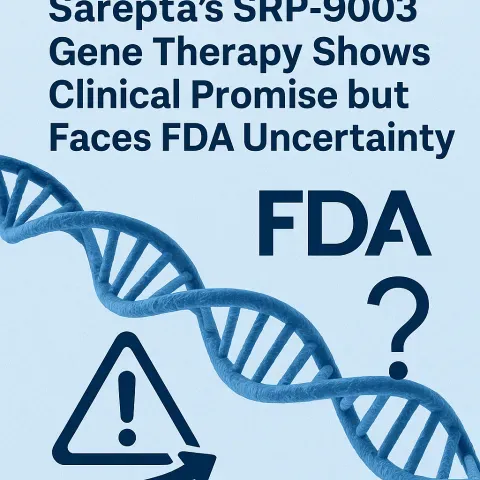
SHERIDAN, WYOMING – October 15, 2025 – Sarepta Therapeutics is pressing forward with its limb-girdle muscular dystrophy (LGMD) gene therapy, SRP-9003, despite a strategic pivot earlier this year toward small interfering RNA (siRNA) therapies and ongoing regulatory challenges. New late-stage data presented at the World Muscle Society Congress in Vienna suggest the therapy could still hold clinical and commercial potential—if Sarepta can navigate FDA scrutiny and rebuild trust in its gene therapy platform.
Promising Clinical Outcomes at WMS 2025
At the 30th annual World Muscle Society (WMS) meeting, Sarepta shared Phase III data from its EMERGENE trial evaluating SRP-9003 in 17 LGMD patients. The therapy, designed to restore beta-sarcoglycan expression—a key muscle-stabilizing protein—met its primary endpoint after 60 days of observation.
- Non-ambulatory patients achieved a 23.9% increase in beta-sarcoglycan expression.
- Ambulatory patients saw a 43.4% rise.
Importantly, despite earlier safety concerns with Sarepta’s platform, no serious adverse events were deemed related to SRP-9003. More than 40% of participants experienced elevated liver enzymes, but these were not linked to the therapy itself.
Analysts See a Strong Rationale to Continue
Industry observers believe the data justify Sarepta’s decision to maintain investment in SRP-9003. “I don’t think they’d continue if the NPV [net present value] analysis wasn’t positive,” said Uy Ear, vice president of U.S. Healthcare–Biotechnology at Mizuho Securities, emphasizing that the decision aligns with risk-adjusted portfolio logic.
Andy Chen, senior analyst at Wolfe Research, added that SRP-9003 remains the LGMD program closest to commercialization: “They are likely going forward with 9003 over the others because it is the closest to market.”
Sarepta has previously indicated plans to file a Biologics License Application (BLA) by the end of 2025—a critical milestone that could determine the company’s future in gene therapy after recent setbacks.
Balancing Commercial Logic with Patient Commitment
Beyond market considerations, Sarepta continues to position SRP-9003 as a commitment to the LGMD 2E community, whose condition stems from mutations affecting beta-sarcoglycan production. The therapy delivers a full-length copy of the gene, aiming for sustained protein expression and functional recovery.
According to Ear, Sarepta’s focus on the 2E subgroup “largely [comes] because they feel a duty to these patients to continue.” Analysts note that Sarepta’s community-driven approach has historically built strong advocacy around its therapies, softening the blow of regulatory turbulence.
Regulatory Pause Adds Uncertainty
Following three patient deaths tied to its gene therapy platform, the FDA placed all Sarepta LGMD programs on clinical hold, citing “an unreasonable and significant risk of illness or injury.” This includes SRP-9003.
Louise Rodino-Klapac, vice president of R&D and technical operations at Sarepta, stated that “Sarepta’s immediate focus for SRP-9003 is to complete the necessary regulatory interactions and submit a BLA as soon as possible, pending the outcome of discussions with FDA.”
The regulatory headwinds have only intensified since June 2025, when the FDA revoked Sarepta’s Platform Technology Designation—a first-ever approval for a viral vector—after additional safety concerns emerged.
Investor and Analyst Perspectives on Risk
Analysts remain divided over the asset’s risk profile. Jefferies’ Andrew Tsai noted that their probability of success rating for SRP-9003 “has declined after the FDA dynamics.” Wolfe Research’s Chen took a harsher stance: “We assign no value to 9003 in our model given extreme FDA uncertainty.”
The FDA’s recent rejections of other advanced biologics, including Capricor’s deramiocel and Replimune’s RP1, underscore a tougher regulatory environment. SRP-9003’s reliance on the same viral vector as Sarepta’s halted SRP-9004 could prompt additional data requests before approval.
Safety Strategy and Future Outlook
To address safety concerns, Sarepta is testing a prophylactic regimen with sirolimus, an immunosuppressant that may prevent acute liver damage. Early independent analyses at WMS suggest potential benefit, though results were not statistically significant.
Tsai believes this approach could support FDA discussions: “We are curious if SRPT’s planned sirolimus study for Elevidys in non-ambulatory DMD patients could be useful to FDA in interpreting the label for ’9003.” Ear agrees that if effective, “they can make the same proposal to the FDA for 9003, as Elevidys and LGMD use the same AAV vector.”
Despite regulatory setbacks, SRP-9003 remains Sarepta’s most advanced LGMD candidate and could play a key role in stabilizing the company’s transition from gene therapy to siRNA. A successful submission would not only validate its scientific platform but also restore investor confidence in the biotech’s long-term pipeline.